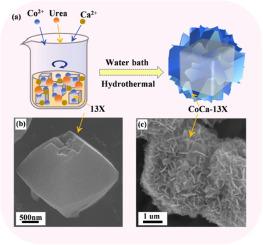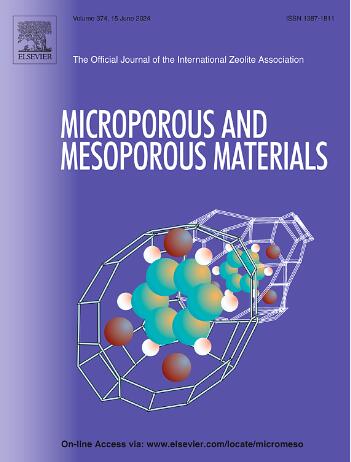Facile coating Co/Ca-silicate on 13X for enhanced degradation of metronidazole via peroxymonosulfate activation: Catalytic performance and toxicity evolution
IF 4.8
3区 材料科学
Q1 CHEMISTRY, APPLIED
引用次数: 0
Abstract
A facile urea-assisted hydrothermal method was developed for synthesizing Co(Ca)-silicate nanosheets@13X (CoCa-13X) as catalyst materials for peroxymonosulfate activation. Urea gradually dissolves 13X to form the silicate anion, and anchors Co2+ ions to the surface of 13X, while introducing Ca2+ ions to form in situ Co/Ca-silicates. The degradation efficiency and reusability of the compound catalyst for metronidazole (MNZ) were investigated. The results demonstrated that at an initial concentration of 25 mg/L, the CoCa-13X-PMS system exhibited excellent catalytic degradation performance towards MNZ, and the degradation rate reached 99.52 % within 5 min. Furthermore, the CoCa-13X-PMS system maintained high catalytic activity against various organic pollutants and even at high concentrations of pollutants (up to 30 mg/L). Free radical quenching experiments revealed simultaneous participation of SO4•– and 1O2 in the oxidation process simultaneously. Additionally, the degradation mechanism and pathway of MNZ were studied and proposed, along with evaluation of biotoxicity associated with its degradation intermediates. This method offers a novel strategy for synthesizing silica zeolite-based cobalt catalysts with exceptional PMS activity for removal of organic pollutants.

在 13X 上涂覆硅酸钴/硅酸钙,通过过一硫酸盐活化促进甲硝唑降解:催化性能和毒性演变
研究人员开发了一种简便的尿素辅助水热法,用于合成过硫酸盐活化催化剂材料--Co(Ca)-硅酸盐纳米片@13X(CoCa-13X)。尿素逐渐溶解 13X 形成硅酸盐阴离子,并将 Co2+ 离子锚定在 13X 表面,同时引入 Ca2+ 离子在原位形成 Co/Ca 硅酸盐。研究了甲硝唑(MNZ)复合催化剂的降解效率和可重复使用性。结果表明,在初始浓度为 25 mg/L 时,CoCa-13X-PMS 系统对 MNZ 具有优异的催化降解性能,5 分钟内降解率达到 99.52%。此外,CoCa-13X-PMS 系统对各种有机污染物都能保持较高的催化活性,甚至在污染物浓度较高(达 30 mg/L)时也是如此。自由基淬灭实验表明,SO4 和 1O2 同时参与了氧化过程。此外,还研究并提出了 MNZ 的降解机制和途径,并对其降解中间产物的生物毒性进行了评估。该方法为合成具有优异 PMS 活性的硅沸石基钴催化剂提供了一种新策略,可用于去除有机污染物。
本文章由计算机程序翻译,如有差异,请以英文原文为准。
求助全文
约1分钟内获得全文
求助全文
来源期刊

Microporous and Mesoporous Materials
化学-材料科学:综合
CiteScore
10.70
自引率
5.80%
发文量
649
审稿时长
26 days
期刊介绍:
Microporous and Mesoporous Materials covers novel and significant aspects of porous solids classified as either microporous (pore size up to 2 nm) or mesoporous (pore size 2 to 50 nm). The porosity should have a specific impact on the material properties or application. Typical examples are zeolites and zeolite-like materials, pillared materials, clathrasils and clathrates, carbon molecular sieves, ordered mesoporous materials, organic/inorganic porous hybrid materials, or porous metal oxides. Both natural and synthetic porous materials are within the scope of the journal.
Topics which are particularly of interest include:
All aspects of natural microporous and mesoporous solids
The synthesis of crystalline or amorphous porous materials
The physico-chemical characterization of microporous and mesoporous solids, especially spectroscopic and microscopic
The modification of microporous and mesoporous solids, for example by ion exchange or solid-state reactions
All topics related to diffusion of mobile species in the pores of microporous and mesoporous materials
Adsorption (and other separation techniques) using microporous or mesoporous adsorbents
Catalysis by microporous and mesoporous materials
Host/guest interactions
Theoretical chemistry and modelling of host/guest interactions
All topics related to the application of microporous and mesoporous materials in industrial catalysis, separation technology, environmental protection, electrochemistry, membranes, sensors, optical devices, etc.
 求助内容:
求助内容: 应助结果提醒方式:
应助结果提醒方式:


